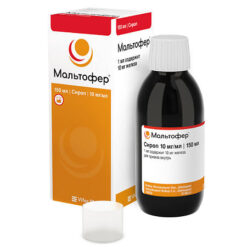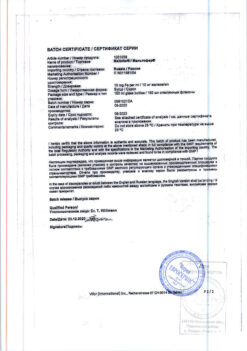No products in the cart.
Plogrel, tablets 75 mg 28 pcs
€1.00
Out of stock
(E-mail when Stock is available)
Description
Plogrel is an antiaggregant. Selectively reduces the binding of adenosine diphosphate (ADP) to receptors on platelets and the activation of glycoprotein IIb/IIIa receptors under the action of ADP, weakening platelet aggregation.
Decreases platelet aggregation caused by other agonists by preventing their activation by free ADP, does not affect FDE activity. Irreversibly binds to platelet ADP receptors, which remain immune to ADP stimulation for the life cycle (about 7 days).
Inhibition of platelet aggregation is observed 2 hours after the initial dose of 400 mg (40% inhibition). The maximum effect (60% inhibition of aggregation) develops after 4-7 days of continuous use at a dose of 50-100 mg/day. The antiaggregant effect persists for the entire period of platelet life (7-10 days).
Indications
Indications
Plogrel is an antiaggregant. Selectively reduces the binding of adenosine diphosphate (ADP) to receptors on platelets and the activation of glycoprotein IIb/IIIa receptors under the action of ADP, weakening platelet aggregation.
Decreases platelet aggregation caused by other agonists by preventing their activation by free ADP, does not affect FDE activity. Irreversibly binds to platelet ADP receptors, which remain immune to ADP stimulation for the life cycle (about 7 days).
Inhibition of platelet aggregation is observed 2 h after the initial 400 mg dose (40% inhibition). The maximum effect (60% inhibition of aggregation) develops after 4-7 days of continuous use at a dose of 50-100 mg/day. The antiaggregant effect persists for the entire period of platelet life (7-10 days).
Active ingredient
Active ingredient
Composition
Composition
Per film-coated tablets 1 tablet contains clopidogrel hydrosulfate 100.8 mg, which corresponds to the content of clopidogrel 75 mg.
How to take, the dosage
How to take, the dosage
It is taken orally, regardless of meals.
For prevention of thrombotic complications in patients with myocardial infarction, ischemic stroke or peripheral artery occlusion, administer 75 mg once daily. In patients with myocardial infarction, treatment can be started from the first day to the 35th day of myocardial infarction, and in patients with ischemic stroke – within 7 days to 6 months after ischemic stroke.
To prevent thrombotic complications in acute coronary syndrome without ST-segment elevation (unstable angina pectoris, myocardial infarction without Q-wave), it is started with a single loading dose of 300 mg and then taken in 75 mg/day (in combination with acetylsalicylic acid in doses 75-325 mg/day, the recommended dose is 100 mg/day). The maximum favorable effect occurs after 3 months. The course of treatment is up to 1 year.
For prevention of thrombotic complications in acute ST-segment elevation coronary syndrome (acute ST-segment elevation myocardial infarction), 75 mg/day with an initial single loading dose in combination with acetylsalicylic acid and thrombolytics (or without thrombolytics) is indicated.
Combination therapy is started as soon as possible after the onset of symptoms and continued for at least 4 weeks.
In patients over 75 years of age, treatment with clopidogrel should be started without a loading dose.
In patients with genetically determined decreased CYP2C19 isoenzyme function, the effect of clopidogrel may be reduced. The optimal dosing regimen in these patients has not been established.
The experience of use in patients with chronic renal impairment or moderate hepatic impairment is limited.
Interaction
Interaction
The concomitant administration of warfarin with clopidogrel may increase the intensity of bleeding, so this combination is not recommended.
The administration of glycoprotein IIb/IIIa inhibitors, acetylsalicylic acid, heparin together with clopidogrel increases the risk of bleeding.
Concomitant use with NSAIDs may increase the risk of bleeding.
Simultaneous use with CYP2C19 isoenzyme inhibitors (e.g., omeprazole) is not recommended.
The active metabolite of clopidogel inhibits the activity of the CYP2C9 isoenzyme, which may result in increased plasma concentrations of phenytoin, tolbutamide and NSAIDs.
Special Instructions
Special Instructions
During treatment it is necessary to monitor the parameters of the hemostasis system (ABTB, platelet count, tests of platelet functional activity); regular examination of liver functional activity.
Clopidogrel should be used with caution in patients at risk of major bleeding in trauma, surgery, patients with bleeding-prone injuries (especially gastrointestinal and intraocular), as well as in patients receiving acetylsalicylic acid, NSAIDs (including COPD inhibitors).COX-2 inhibitors), heparin or glycoprotein IIb/IIIa inhibitors. Patients should be closely monitored to detect any signs of bleeding, including hidden bleeding, especially during the first weeks of using the drug and/or after invasive cardiac procedures or surgical operations. Simultaneous use of clopidogrel and warfarin is not recommended because it may increase bleeding.
In case of surgical interventions, if antiaggregant effect is undesirable, the treatment should be discontinued 7 days before surgery.
Patients should be warned that since it takes longer to stop bleeding when using clopidogrel (with or without acetylsalicylic acid), they should inform their physician about each bleeding event. Patients should also inform their physician about taking the drug if they are going to have surgical interventions.
Thrombotic thrombocytopenic purpura has been found very rarely after clopidogrel administration, sometimes after short-term use. This condition is characterized by thrombocytopenia and microangiopathic hemolytic anemia combined with neurologic signs, impaired renal function or fever.
Thrombotic thrombocytopenic purpura is a potentially fatal condition that requires immediate treatment, including the use of plasmapheresis.
Because of the lack of data, clopidogrel should not be recommended for acute (less than 7 days) ischemic strokes.
The experience of using clopidogrel in patients with impaired renal function is limited; therefore, clopidogrel should be prescribed with caution in these patients.
In severe hepatic impairment, be aware of the risk of hemorrhagic diathesis; experience with the drug in patients with moderate hepatic impairment is limited, so clopidogrel should be prescribed with caution in these patients.
Influence on driving and operating ability
Influence on driving and operating ability
. Clopidogrel may cause nervous system side effects (headache, dizziness, systemic dizziness, confusion, hallucinations) that may affect the ability to drive and engage in other potentially dangerous activities requiring increased concentration and rapid psychomotor reactions.
Contraindications
Contraindications
Severe hepatic impairment;
Acute bleeding (including peptic ulcer or intracranial hemorrhage);
Lactose intolerance, lactase deficiency, and glucose/galactose malabsorption syndrome;
Children and adolescents under 18 years of age (efficacy and safety of use have not been established);
Pregnancy;
Lactation period;
High sensitivity to the components of the drug.
The drug should be used with caution in moderate hepatic insufficiency, chronic renal insufficiency, pathological conditions which increase the risk of bleeding (including trauma, surgeries), susceptibility to bleeding, concomitant use of acetylsalicylic acid, warfarin, NSAIDs (including COX-2 inhibitors), heparin, glycoprotein IIb/IIIa inhibitors, inherited decreased CYP2C19 isoenzyme function.
Side effects
Side effects
Bleeding is the most common reaction that occurs during the first month of taking the drug. Cases of severe bleeding have been reported in patients taking clopidogrel concomitantly with acetylsalicylic acid or clopidogrel with acetylsalicylic acid and heparin.
The frequency of side effects is defined according to the following criteria: very frequently (>1/10), frequently (>1/100 and1/1000 and1/10 000 and
Hematopoietic organs: infrequently – thrombocytopenia, leukopenia, eosinophilia; rarely – neutropenia, includingVery rarely – thrombotic thrombocytopenic purpura, anemia including aplastic anemia, pancytopenia, agranulocytosis, severe thrombocytopenia, granulocytopenia.
Nervous system disorders: infrequent – headache, dizziness, paresthesia, intracranial hemorrhage, including fatal; very rare – mental confusion, hallucinations.
Sensory organs: infrequent conjunctival hemorrhage, retinal haemorrhage; rare – vertigo; very rare – taste disorders.
Cardiovascular system: very rarely – vasculitis, decreased blood pressure.
With the blood coagulation system: often – hematoma; very rare – severe bleeding, bleeding from the operating wound.
Respiratory system disorders: very common – nasal bleeding; very rare – bronchospasm, interstitial pneumonitis, pulmonary bleeding, hemoptysis.
The digestive system: frequently – diarrhea, abdominal pain, dyspepsia, gastrointestinal bleeding; infrequently – gastric and duodenal ulcer, gastritis, vomiting, nausea, constipation, flatulence; rarely – retroperitoneal bleeding; very rarely – pancreatitis, colitis, including ulcerative or lymphatic ulcer.including ulcerative or lymphocytic, stomatitis, acute liver failure, hepatitis, impaired liver function tests, gastrointestinal bleeding with lethal outcome.
Dermatological reactions: frequently – subcutaneous hemorrhage; infrequently – skin rash, itching, purpura; very rarely – erythematous rash, erythema multiforme, Stevens-Johnson syndrome, toxic epidermal necrolysis, eczema, lichen planus red.
Muscular system disorders: very rarely – haemarthrosis, arthritis, arthralgia, myalgia.
As to the urinary system: infrequent – hematuria; very rare – glomerulonephritis, hypercreatininemia.
Allergic reactions: very rarely – angioedema, urticaria, anaphylactic reactions, serum sickness.
Laboratory disorders: infrequent – prolongation of bleeding time, liver function test disorders, increased concentration of blood creatinine.
Others: very rare – increase in body temperature.
Overdose
Overdose
Symptoms: prolongation of bleeding time and subsequent hemorrhagic complications.
Treatment: if bleeding is detected, symptomatic hemostatic therapy is carried out. No antidotes to the pharmaceutical activity of clopidogrel have been found. If rapid correction of prolonged bleeding time is necessary, platelet transfusion is recommended.
Pregnancy use
Pregnancy use
In the absence of data, clopidogrel should not be used during pregnancy and lactation (breastfeeding).
Similarities
Similarities
Additional information
| Shelf life | 3 years |
|---|---|
| Conditions of storage | The drug should be kept out of reach of children, protected from light at a temperature not exceeding 25 ° C |
| Manufacturer | Oxford Laboratories Pvt. Ltd. |
| Medication form | pills |
| Brand | #Н/Д |
Related products
Buy Plogrel, tablets 75 mg 28 pcs with delivery to USA, UK, Europe and over 120 other countries.















